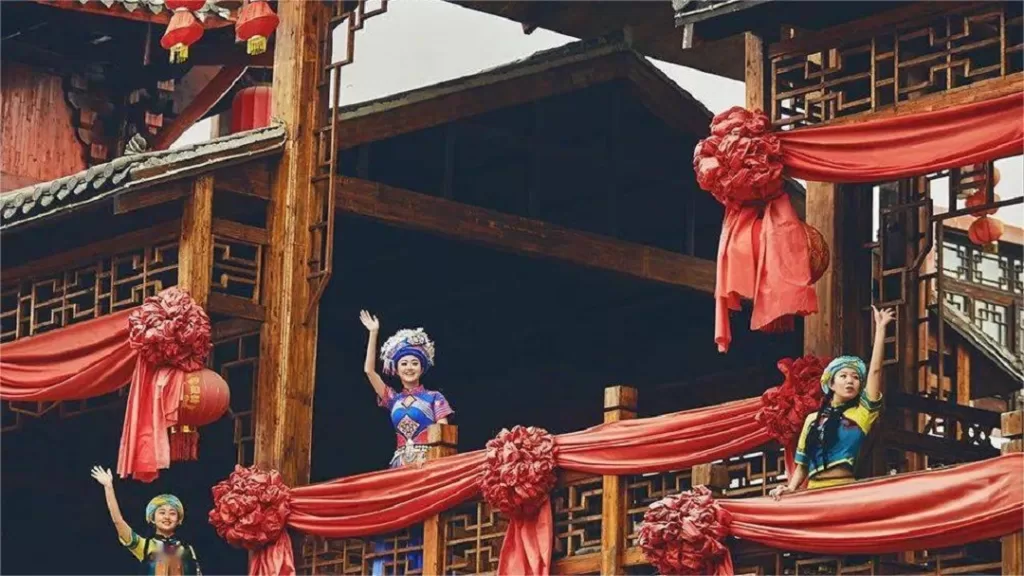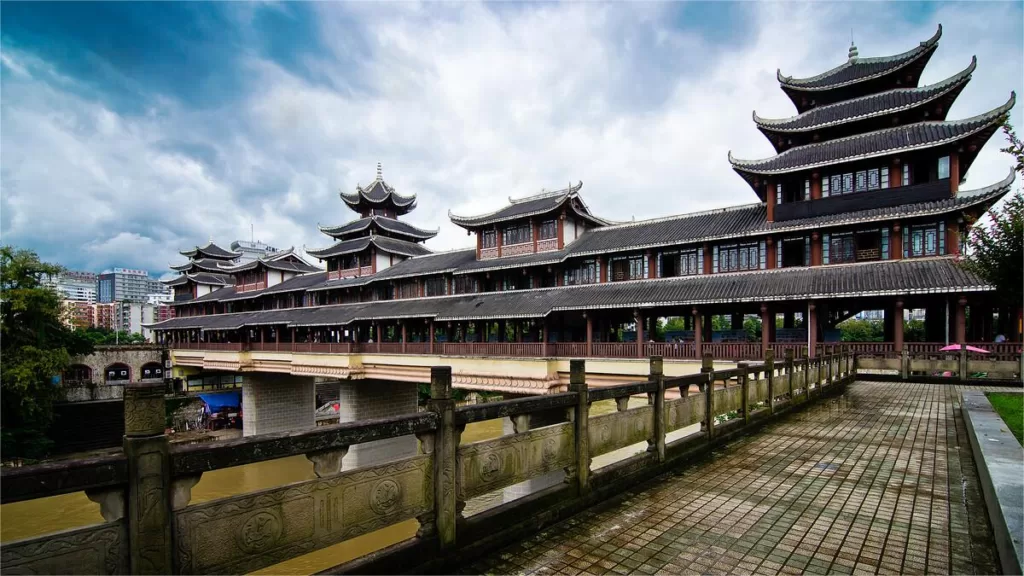Enshi Tusi City (恩施土司城) is situated in the northwest of Enshi Tujia and Miao Autonomous Prefecture, Hubei Province, China. It stands out as the largest, most magnificent, uniquely styled, and picturesque Tujia cultural landmark in the country. Comprising various attractions like the archway, Dong ethnic rain bridge, Linjun ancestral temple, drill ground, Tujia dwellings, Tusi palace known as Jiujintang, city walls, bell tower, drum tower, Baihua Garden, and Ethnic Arts Garden, the city showcases the historical roots and rich customs of the Tujia ethnic group.
The Tusi system was a political governance structure in feudal China where certain minority regions were allowed central authority while maintaining local autonomy. In the Tujia region, the Tusi system originated during the Yuan Dynasty and lasted until the 13th year of the Qing Dynasty’s Yongzheng era, spanning over 450 years across the Yuan, Ming, and Qing dynasties. The relationship between Tusi and the central feudal dynasties involved the Tusi paying tribute to and acknowledging the authority of the central government, while the central government granted them the right to autonomy. The territories governed by Tusi were not incorporated into the central government’s territory, and their population was not included in the household registration. They held power over life and death in their domain, essentially acting as local emperors.
Table of Contents
- Basic Information
- Location and Transportation
- Highlights of ENshi Tujia City
- Vlog about Enshi Tusi City
- Useful Tips Summarized from Reviews
- Other Attractions in Enshi Urban Area
Basic Information
| Estimated Length of Tour | 1 – 2 hours |
| Ticket Price | 50 RMB |
| Opening Hours | 7.30 – 18.00; Last admission: 18.00 (1st April – 8th October) 8.00 – 17.30; Last admission: 17.30 (9th October – 31st March) |
| Telephone Number | 0086-0718-8458166 |
Location and Transportation
Enshi Tusi City is situated in the northwestern part of Enshi City, Hubei Province, within the Enshi Tujia and Miao Autonomous Prefecture. It is located approximately 500 meters from the Enshi City government headquarters. The specific address is 138 Tusi Road.
To get there, tourists can take bus 1B, 30, 37, 39 or Double-deck Sightseeing Line and get off at Tusicheng Stop (土司城站).
Highlights of ENshi Tujia City
Gate Tower of Tusi City

The Gate Tower of Tusi City stands as a commemorative structure, symbolizing the dignity and merit of the Tusi rulers. It is an architectural marvel, meticulously designed with a grand and ornate exterior. Rising to a height of 25 meters and spanning a width of 12 meters, the tower is constructed entirely with traditional mortise-and-tenon joints using wood. Two spiral staircases on either side lead to the top, creating a seamless connection between the floors. The tower features 200 doors and 189 intricately carved openwork patterns on windows, predominantly depicting theatrical scenes and folk legends.
Remarkably, the Gate Tower incorporates many clever and double-meaning numerical elements into its design. With 4 stories, 12 columns, and 24 beams, these numbers symbolize the four seasons, twelve months, and twenty-four solar terms in a year. The intentional use of these figures adds depth and cultural significance to the structure.
At the forefront of the tower, on both sides, stand statues of celestial beings leading dragons, known as “Tianwang Songzi” or “Heavenly King Offering Sons.” This representation reflects the common aspiration among the Tujia people for their offspring to achieve greatness, echoing the Chinese cultural motif of “hoping for one’s child to become a dragon.”
On the right wall, three murals capture attention. In the middle, a depiction of ethnic unity is evident, while the right mural portrays “Maogusu,” reflecting the ancestral life of the Tujia people. “Maogusu” refers to the deity of rice, emphasizing the profound connection between rice cultivation and human survival. The worship of the rice deity reflects the strong awareness of life’s existence among the Tujia ancestors during the early stages of agriculture.
On the left mural, two robust figures with keen and vigilant eyes, referred to as “Nuribaga” and “Kedou Maoren” in the Tujia language, serve as the guardians of the Gate Tower. Their fierce gaze appears to scrutinize every passerby, embodying the protective spirits of the Tusi City Gate Tower.
Linjun Ancestral Temple

Perched on the mountain opposite the cruise ship terminal is the revered Linjun Ancestral Temple, a sacred site for the Tujia ethnic group. The temple is a three-story, three-section, multi-eaved structure with columned corridors, facing west to east. It stands proudly on the mountainside, exuding a majestic and imposing presence. Adjacent to the temple, along the mountain wall, an enormous scroll mural illustrates the heroic deeds and passionate life of Linjun, the ancestral figure.
Legend has it that in ancient times, the ancestor of the Tujia people, Ba Wuxiang, was elevated as the chieftain of the five tribal clans, known as “Linjun.” Initially residing in Wuluo Zhongli Mountain (present-day Changyang Tujia Autonomous County in Hubei), the five clans included Ba, Fan, Hui, Xiang, and Zheng. The Ba clan originated from the Red Cave, while the other four clans originated from the Black Cave. Ba Wuxiang, the son of the Ba clan, became the leader of the five clans and was honored as Linjun. Over time, the influence of Linjun expanded, leading the five clans westward along the Yi River (now Qingjiang), reaching Yanyang (modern-day Yanjing Temple). Subsequently, they expanded eastward in Sichuan, gaining control over the region.
Tusi Palace – Jiujintang

Jiujintang, also known as the Nine-Entrance Hall, stands as the core of the entire Tusi City. It is a remarkable structure composed of 333 columns, 333 stone pillar bases, 330 doors, thousands of intricately carved wooden windows, over a thousand beams, and tens of thousands of components. With a depth of 99.99 meters, a width of 33 meters, and a total floor area of 3999 square meters, it represents a rare example of pure mortise-and-tenon wooden architecture in China. The grandeur of Jiujintang is evident in its meticulous design, with pavilions, towers, and flying eaves arranged in a harmonious and majestic manner. Jiujintang stands as an authentic Tusi imperial palace, showcasing a magnificent and regal presence.
Stilted House

The stilted house, known as “吊脚楼” in Chinese, is a traditional Tujia ethnic dwelling found in Tusi City. Typically constructed along hillsides and water sources, these houses often feature fruit trees and bamboo groves surrounding them. Stilted houses are generally two stories with three rooms. The upper floor consists of two rooms on the left, grounded, and one room on the right, suspended. The left side typically serves as the kitchen, the middle as the main hall, and the right as additional living space. The lower level of the house lacks walls but is supported by pillars, giving it the distinctive “stilted” appearance. This design not only protects against harm from snakes and wild animals but also allows for livestock keeping, storage of heavy furniture, and the stacking of firewood, while the upper floor.
Tusi City Wall

The Tusi City Wall spans a total length of 2320 meters, with a width of 1.2 meters, skillfully constructed to follow the contours of the mountainside, creating a majestic and continuous presence. During the Tusi period, as local rulers aimed to expand their economic strength, they simultaneously reclaimed land for cultivation and engaged in territorial disputes, sometimes resorting to coercion and raiding local populations to increase their labor force. This resulted in frequent wars between different Tusis, leading each Tusi to construct defensive walls around their territories, serving as crucial fortifications against attacks and invasions. The city walls also incorporated watchtowers for signaling through smoke signals, facilitating rapid communication and mobilization of Tusi soldiers to defend against external threats. The Tusi City Wall stands as a testament to the historical context of conflicts and defensive strategies employed during this period.
Bell Tower

The Bell Tower in Tusi City stands at the highest point of the city wall, characterized by a three-story pavilion-style structure. The bottom tier serves as the city wall, the middle tier as the tower, and the top tier as the pavilion. With four pillars and four eaves, it provides a panoramic view of the four cardinal directions. Suspended within the pavilion is a massive bronze bell, weighing over 3000 kilograms, known as the Tusi Morning Ceremony Bell. The bell is inscribed with 999 characters, recounting the magnificent landscapes of Tusi City and the poignant history of the ancient Ba people and their descendants, the Tujia ethnic group.
The Tusi Morning Ceremony Bell is primarily used for Tujia ethnic religious ceremonies. It is also employed during the enthronement celebrations for new Tusi rulers and the annual prayers for relief from natural disasters. When the bell tolls, the Tusi leader, along with officials, royal relatives, soldiers, and local residents, gather for solemn rituals, adding a sense of grandeur and sacredness to the occasion.
White Tiger Statue

Descending along the beacon tower leads to White Tiger Mountain in Tusi City, where a prominent White Tiger statue stands. The White Tiger is the revered embodiment of the ancestral spirit of Linjun, highly worshiped by the Tujia ethnic group. Consequently, the White Tiger holds a significant place as the totemic symbol and emblem of the Tujia people, earning them the designation of the “Tiger Clan.”
Due to the Tujia people’s profound reverence for the tiger, numerous temples are dedicated to its worship, and many Tujia households feature shrines adorned with White Tiger figurines. Additionally, various places are named with the character “虎” (tiger), such as “White Tiger Mountain” in Xianfeng County and “White Tiger Hall” in Laofeng County. Locations like “Tiger Ridge” and “Tiger Slope” also reflect the tiger-centric cultural significance. Even the traditional attire of Tujia children includes “Tiger Head Shoes,” while adults often draw a character resembling “王” (king) on the foreheads of children, symbolizing the hope for the prosperous future of the next generation, seen as descendants of the tiger.
Tingtao Tea House

Tingtao Tea House, located along the secluded Quanshui Creek in the peaceful Wohu Valley, is a charming and unique waterside teahouse with a simple, natural, and elegant design. While Enshi is often celebrated for its music and dance, it also boasts a natural affinity for tea cultivation. Notably, Xuan’en’s Wujiatai tea was granted the imperial title of “Royal Favor,” earning a reputation as a renowned tribute tea. Other tea varieties, such as Lichuan’s “Cloud Mist Tea” and Hefeng’s “White Crane Tea,” alongside Enshi’s own “Selenium-rich Tea,” contribute to a diverse selection of premium teas. Adjacent to the teahouse is a venerable “Tea Tree King” over 300 years old, displaying an eternal vitality by budding new shoots every spring, symbolizing the timeless essence of tea culture in Enshi.
Vlog about Enshi Tusi City
Useful Tips Summarized from Reviews
Free Tujia Song and Dance Performance: Arrive at the Tusi City before 10:00 AM to catch the free Tujia song and dance performance at the Jiujintang Hall. This cultural show provides insights into the traditional music and dance of the Tujia ethnic group.
Rent Ethnic Costumes: For a more immersive experience, consider renting ethnic costumes for 20 yuan per set. There is no time limit for wearing them, allowing you to take photos at your leisure and capture the essence of Tujia culture.
Different from Tangya Tusi City Ruins: It’s important to note that Enshi Tusi City is distinct from the Tangya Tusi City Ruins. Ensure you’re heading to the correct location to avoid confusion.
Scenic Bamboo Grove: Adjacent to the square in front of Jiujintang Hall, there is a picturesque bamboo grove. This serene setting serves as an excellent backdrop for photography, offering a tranquil ambiance amidst the bustling city.




